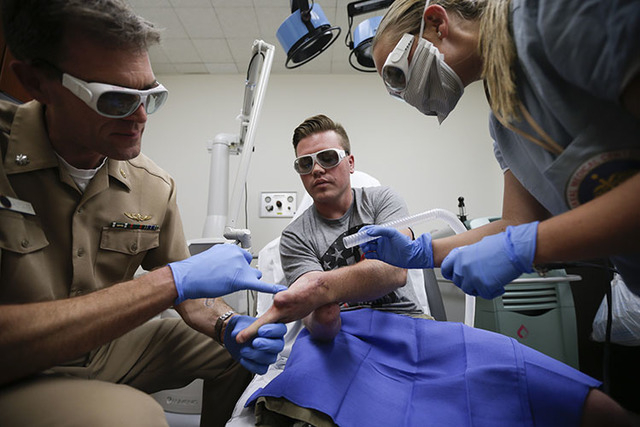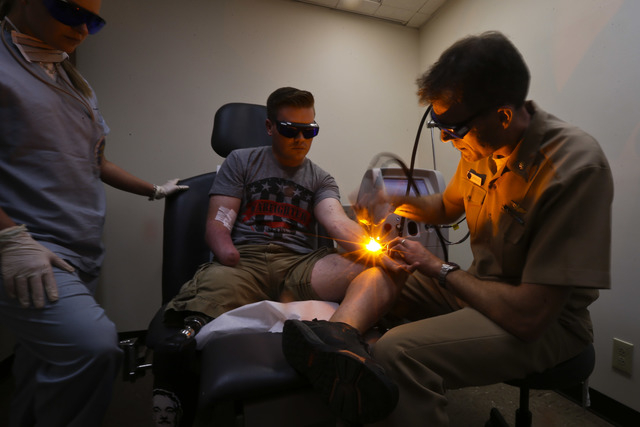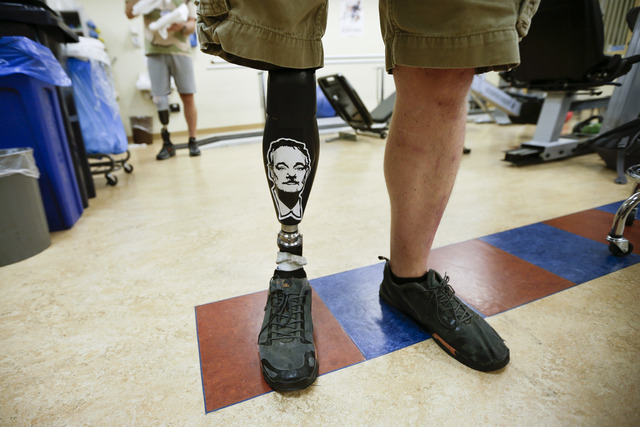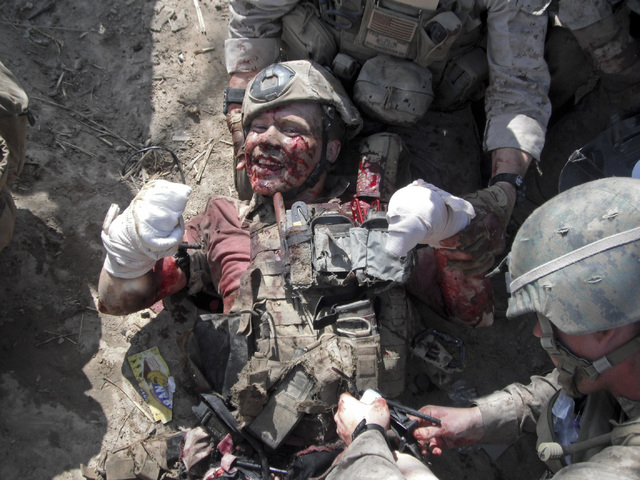Improved military medicine on horizon for disabled vets





SAN DIEGO — The blood is not the most jarring part of the photograph taken shortly after the bomb blew off Marine Gunnery Sgt. Brian Meyer’s leg and hand.
It’s his smile.
The bomb technician had asked a team member to take the picture. He knew his defiance in the face of death would keep his comrades going and ease the torment caused by what they had witnessed.
His attitude set the tone for the long journey the double amputee is taking along with nearly 2,000 troops who lost one or more limbs from combat injuries in Iraq and Afghanistan.
It’s also pushing military medicine to find better ways to accommodate such a large population of young, severely disabled combat veterans who want to maintain an active lifestyle. Many wear out their prosthetic limbs in a matter of months doing everything from mountain climbing to running marathons.
With survival rates reaching historic highs during the two wars, the Naval Health Research Center is launching a major, six-year study on wounded warriors to track their quality of life and better understand the road to recovery.
So far, 1,500 people have signed up for the Wounded Warrior Recovery Project study. The Navy aims to recruit 10,000.
About 50,000 military personnel have been injured in the conflicts in Iraq and Afghanistan, with 16,000 hurt so severely that they likely would not have survived previous conflicts.
Doctors say a positive attitude is key to recovery, so the study will also examine mental resilience and why some troops have it and others don’t. It will rely on Web-based, telephone and mailed surveys conducted every six months about mobility, ability to function and social activity. Researchers will also analyze military databases detailing clinical encounters with each service member injured while deployed.
The study aims to provide one of the broadest reviews yet of how post 9-11 veterans with a variety of combat injuries are coping and enjoying life, and how much their quality of life impacts their long-term care.
Meyer is not yet part of the study but intends to participate. His case was featured in the New England Journal of Medicine in May to demonstrate the success of battlefield trauma care over the past decade.
The retired Marine has benefited from a host of new medical strategies used by the military, including laser treatments.
Cmdr. Peter Shumaker, chief of dermatology at Naval Medical Center San Diego, helped pioneer the use of an ablative laser — commonly used to smooth wrinkled or acne-scarred skin — to ease Meyer’s scar tissue, dramatically improving the range of motion in his fingers, among other things.
“It’s a privilege to work with soldiers and Marines, like Brian, because they’re young and motivated and healthy and they can go farther than we ever thought,” Shumaker said. “They don’t want to just walk, they want to do things that their colleagues are doing, their friends are doing.”
Meyer was hospitalized for a month after the 2011 bomb blast in Afghanistan. He lost his right leg above the knee, and his right hand above the wrist. Only his pinky and ring finger remained intact on his left hand.
After multiple surgeries, he was outfitted for prosthetics and learned to walk again. But Meyer, 29 at the time, wanted full independence.
He turned down offers to install wheelchair ramps in his home. He debated before accepting a handicap parking permit. He did not want to avoid the struggle to reintegrate. He wanted to go anywhere.
“I focus on what I have left, not what I lost,” Meyer said.
His prosthetic arm has a flashlight so at night he can see where he plants his prosthetic foot. His prosthetic arm has the knobs and battery pack positioned to one side so he can shoot a bow and arrow.
Thanks to the laser treatments on his scar tissue, he can now hold a toothbrush, write with a pen, dial his phone, and pull the trigger of a hunting rifle. Laser treatments also removed a sore, allowing him to withstand his prosthetic leg for 18 hours a day.
Shumaker and Dr. Chad Hivnor, who recently retired from Lackland Air Force Base, helped pioneer the method. Hivnor also discovered botulinum toxin A injections decrease perspiration where the prosthetic limb attaches, helping stop it from slipping off while the person is exercising or in hot climates.
The findings were recently presented to the American Academy of Dermatology to promote the treatment for severely scarred people in the general population.
“These are not special, scar lasers or special, wounded warrior lasers,” Shumaker said. “We’ve taken these techniques that are primarily used for cosmetic purposes and altered them a bit to apply to trauma rehabilitation.”
Such unconventional treatments make a big difference in daily life, veterans and their doctors say. One soldier’s scar tissue has softened so he can grasp his daughter’s hand; another can now type.
A week after a recent treatment, Meyers rode on his motorcycle through a shopping district in Murrieta, 60 miles northeast of San Diego. His pinky and ring finger operated the throttle that has been put on the left side because he only has a left wrist. It has a side car that can carry another amputee, wheelchair or his dog.
Meyer and two others have started the nonprofit organization, Warfighter Made, which modified his motorcycle. It also customizes sports cars, off-road vehicles and other transportation for veterans, who can join in the work.
“What we want is for a guy in the coolest car to drive into a handicap spot and have people be like, ‘What’s this guy doing?’ Then they see him get out with his prosthetic legs,” said Meyer, whose prosthetic leg sports a sticker of Bill Murray and the word “Laugh.”
Meyer works for the Injured Marines Semper Fi Fund, counseling fellow combat veterans. He loves the photograph taken after he was injured because “it’s the exact opposite of what somebody expects you to do. So when I show it to people and they are inspired by it, instead of being shocked, I know they get it.”












